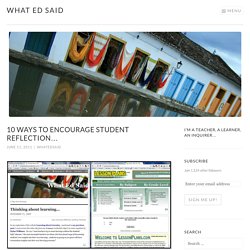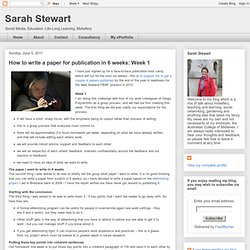

Critical thinking web. Thinking Tools. 10 ways to encourage student reflection. Split Screen Teaching Optimal learning occurs when students are active participants in their own learning, rather than passive recipients of teacher-delivered content.

For this to be effective, students really need to think about their learning. I worked with a group of teachers recently who felt their young students were not capable of writing meaningful reflections for their end of semester reports. That might be true. But only if reflection and meta-cognition are not integral parts of the learning in their classes.
How do we encourage students to think about their learning? 1. Guy Claxton calls this ‘split screen teaching.’ 2. Stop thinking about how to teach the content. 3. Make sure you and your students know the purpose of every task and of how it will advance the learning. 4. Encourage students to plan how they will learn and to reflect on the learning process. 5. Make sure students have time to stop and think about why and how they learned, not just what. 6. 7. 8. 9. 10. Like this: Content creation. How to write a paper for publication in 6 weeks: Week 1. I have just signed up for a face-to-face publication boot camp which will run for the next six weeks - this is to support me to get a couple of papers published by the end of the year in readiness for the New Zealand PBRF process in 2012.

Week 1I am doing this challenge with four of my work colleagues at Otago Polytechnic as a group process, and we had our first meeting this week. The first thing we did was clarify our expectations for the process: Starting with the conclusionThe third thing I was asked to do was to write down 2 - 5 key points that I want the reader to go away with. So here they are: Mapping information and argumentThe second piece of homework is to map the information and arguments that lead up to these key points - this will eventually become the discussion section of the article.
Virtual boot campI mentioned this project in passing and have a number of people interested in doing a similar thing online. The Resurgence of Flipped Learning Chat « Chantellemorrison's Blog. I’ve noticed a revival of the ‘Flipped Learning’ edchat lately.

Having trialled Flipped Learning (AKA Pre-learning*) for nearly 12 months, I thought it would be helpful to share what I’ve gleaned through the process. I’ll do this over a series of 3 blogs; the first blog will focus on how to find appropriate resources and then distribute these resources in a helpful, meaningful way. Before embarking on a flipped learning program, it’s most crucial to decide on your goal for flipped learning. Is it an adjunct to a current homework program? Is it to replace/assist in class explicit teaching? Is it to ensure students are prepared for learning a new topic prior to explicit teaching?
Is it for students to realise the gaps in their knowledge of a certain topic and then bring questions forward to the class? If you chose either of the last 2 options, then this blog entry will be of assistance to you. What is it that I want the students to learn/understand? Like this: Like Loading... Skill rubric.